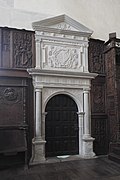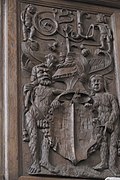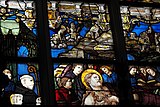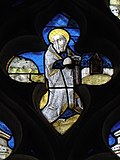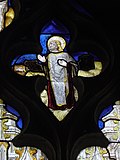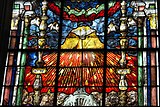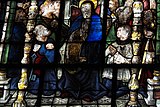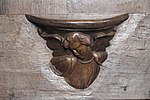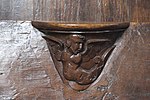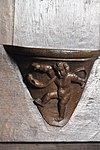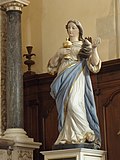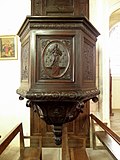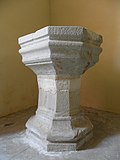Ste-Marie-Madeleine (Champeaux)
The Catholic Church of Sainte-Marie-Madeleine in Champeaux , a parish in the Ille-et-Vilaine department in the French region of Brittany , was built at the beginning of the 15th century. The church has preserved tombs, choir stalls and stained glass windows from the Renaissance . In 1910, the church was added to the list of architectural monuments in France as Monument historique .
history
In 1414, Simon d'Espinay received from John VI. , the Duke of Brittany, permission to build a church on the site of a former leper house, which was to become the burial place of his family. The patronage of the church is reminiscent of the chapel of the previous building, which - as is often the case with leper houses - was also consecrated to Maria Magdalena . The new church was also intended to replace the old parish church , consecrated to the Apostle Peter , which had become dilapidated and was demolished. Robert d'Espinay, Simon's son, established a canons' monastery with six canons around 1432 and Pope Eugene IV raised the church to a collegiate church in 1437. The descendants of the founder, who were buried there and who were elevated to margraves in the 16th century , gave it numerous foundations. Guy III. d'Espinay and his wife Louise de Goulaine commissioned the choir stalls and the large choir window with the crucifixion scene, on which they are shown below.
architecture
The single nave nave , the choir and the Barbara chapel on the north side date from the middle of the 15th century. They are the oldest parts of the church and are covered by wooden pointed barrels. The Jacob's Chapel, which was added to the southern nave opposite the Marienkapelle in the early 16th century, has, like the two patronage chapels, the Marienkapelle in the north, which also dates from the 15th century, and the chapel, which was added to the choir in the south in 1593/94, ribbed vaults with keystones . A sacristy adjoins this southern choir chapel in the west . The choir, which is unusually large in relation to the nave, is due to the placement of the monastery chapter. The bell tower attached to the south of the west facade dates from the 18th century.
Sacristy door
The door to the sacristy was completed in 1594. The inscription “Ricand me fecit” and the year 1594 are carved on the base of the pillars. The door is designed like a triumphal arch and leads to the patronage chapel built in 1593/94 for the tomb of Jean d'Espinay († 1591). On both sides of the door you can see a couple in the wood paneling, a wild man and a wild woman, with coats of arms. The coats of arms were knocked off during the French Revolution.
Leaded glass window
- Window 0
The large choir window, the Crucifixion Window , was executed between 1539 and 1541 and was designed by Guy III. d'Espinay and Louise de Goulaine donated. It is attributed to the glass painter Gilles de La Croix-Vallée. In the middle the crucifixion of Christ is shown between the two thieves and in the tracery the mercy seat . At the bottom of the picture you can see the donor couple and in the middle the ecstasy of St. Mary Magdalene in her cave in the Massif de la Sainte-Baume .
- Window 1
The window depicting the martyrdom of St. Barbara in the St. Barbara's Chapel ( Chapelle Sainte-Barbe ) is dated around 1540. In the upper left scene Barbara is sentenced by her father, in the upper right scene she is tortured, in the lower left scene she is beheaded with a sword and in the lower right scene her father is strangled by demons. Angels take in the saint in the background. In the tracery, angels hold the coat of arms of the Espinay family.
- Window 2
The window with the depiction of the sacrifice of Isaac is in the patronage chapel ( Chapelle seigneuriale ), which adjoins the choir to the south. The chapel originally housed the tomb of Jean d'Espinay († 1591) and his wife Marguerite de Scepeaux, which was destroyed during the French Revolution. Jean d'Espinay was a knight of the Michael order and was by Henry III. appointed marquis . The window was probably donated by his widow around 1594. The coats of arms of the Espinay and Scepeaux families and their alliance coats of arms are shown on the window . The coat of arms of Jean d'Espinay is framed by the chain of the Order of Michael.
- Window 3
The oldest window in the church is in the Lady Chapel ( Chapelle de la Vierge ), the old patronage chapel , which adjoins the nave in the north. The three-lane window is dated around 1500. In the middle lancet above, St. Margaret and St. Barbara are shown with their attributes, the dragon and the tower in the background. On the panes below you can see John the Baptist with the Lamb of God and the Apostle Andrew with the St. Andrew's Cross . A crucifixion group with Mary and John can be seen in the tracery.
- Window 8
The Pentecost window in the St. James chapel ( Chapelle Saint-Jacques ) is marked with the year 1529. In the center it shows the sending of the Holy Spirit on the apostles and Mary. Next to Mary, the apostle Peter kneels , holding a large key, and the canon Jean Masure, the founder of the window. The Trinity is shown above. The execution of the window is attributed to Jean Adrien (also Adrian).
Choir stalls
The wood-carved choir stalls were probably built around 1535 by Guy III. D'Espinay and his wife Louise de Goulaine. It consists of two rows with 27 seats each. Originally it led completely around the choir and was closed to the nave with a rood screen, which was demolished in the middle of the 18th century. The cheeks and back walls are decorated with arabesques, the misericordia show reliefs of animals, heads and human figures.
Further equipment
- The main altar was executed by Pierre Gambier, Métivier and Le Roy between 1748 and 1750. On it are the figures of the apostle Peter, the patron saint of the old parish church, the church patroness Maria Magdalena and in the middle an allegorical representation of faith.
- The pulpit is a work from the 18th century. On the pulpit is Mary Magdalene, surrounded by tears and represented with her attribute , the ointment vessel. The pulpit is accessible through an outside staircase.
- The altar of the Jakobskapelle has five wood-carved relief panels from the first half of the 16th century with scenes of the Passion of Christ. The panels depict the flagellation of Jesus, the carrying of the cross, the crucifixion scene, the descent from the cross and the holy women at the grave. The boards were probably once attached to the rood screen.
- The baptismal font is from the 15./16. Century. The brass lid was renewed in the 19th century.
Tombs
- Guy III's tomb d'Espinay and Louise de Goulaine
The tomb of Guy III designed in the form of a triumphal arch. d'Espinay and his wife Louise de Goulaine stand in the choir, to the side of the main altar. It was created in 1552/53 by the architect Jean de l'Espine from Angers. Originally, the two deceased were shown in the lower part as transi , as naked, decaying corpses, and in the upper part kneeling and in splendid clothing. The figures above were lost during the French Revolution .
- Tomb of Claude d'Espinay
The tomb of Claude d'Espinay, the daughter of Guy III. d'Espinay and Louise de Goulaine, who died in 1554 at the age of 20, is in the Barbara Chapel at the back of their parents' tomb. The tomb made of limestone and marble has a pyramid-like structure. It was probably also executed by Jean de l'Espine between 1555 and 1560.
literature
- Brittany . Hachette, Guides Bleus, Paris 1991, ISBN 2-01-015841-5 , pp. 774-775.
- Champeaux . Inventaire Général des Monuments et des Richesses Artistiques. Direction régionale des Affaires Culturelles (ed.), Rennes undated
- Le Patrimoine des Communes d'Ille-et-Vilaine . Flohic Éditions, Volume 2, Paris 2000, ISBN 2-84234-072-8 , pp. 1686–1690.
- Françoise Gatouillat, Michel Hérold: Les vitraux de Bretagne . (= Corpus Vitrearum ). Volume VII, Presses Universitaires de Rennes, Rennes 2005, ISBN 2-87535-0151-3 , pp. 221-224.
Web links
- Église Sainte-Marie-Madeleine in the Base Mérimée of the French Ministry of Culture (French)
- La collégiale Sainte Marie-Madeleine Commune de Champeaux
Individual evidence
- ↑ Église Sainte-Marie-Madeleine in the Base Mérimée of the French Ministry of Culture (French)
- ↑ Sacristy door in Base Palissy of the French Ministry of Culture (French)
- ↑ Wood paneling in the Base Palissy of the French Ministry of Culture (French)
- ↑ Crucifixion window in Base Palissy of the French Ministry of Culture (French)
- ^ Barbara window in the Base Palissy of the French Ministry of Culture (French)
- ↑ Window of the Sacrifice of Isaac in Base Palissy of the French Ministry of Culture (French)
- ↑ Window 3 in Base Palissy of the French Ministry of Culture (French)
- ↑ Pentecost window in Base Palissy of the French Ministry of Culture (French)
- ↑ Choir stalls in the Base Palissy of the French Ministry of Culture (French)
- ↑ Main altar in the Base Palissy of the French Ministry of Culture (French)
- ↑ Pulpit in Base Palissy of the French Ministry of Culture (French)
- ^ Passion altar in the Base Palissy of the French Ministry of Culture (French)
- ^ Passion altar in the Base Palissy of the French Ministry of Culture (French)
- ↑ Baptismal font in the Base Palissy of the French Ministry of Culture (French)
- ^ Tomb of Guy III. d'Espinay and Louise de Goulaine in the base Palissy of the French Ministry of Culture (French)
- ^ Tomb of Claude d'Espinay in the Base Palissy of the French Ministry of Culture (French)
Coordinates: 48 ° 8 ′ 51.2 " N , 1 ° 18 ′ 40.3" W.



